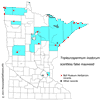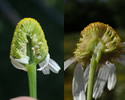Tripleurospermum inodorum (Scentless False Mayweed)
| Also known as: | Scentless Chamomile, False Chamomile |
|---|---|
| Genus: | Tripleurospermum |
| Family: | Asteraceae (Aster) |
| Life cycle: | annual, short-lived perennial |
| Origin: | Europe |
| Status: |
|
| Habitat: | sun; disturbed soil; roadsides, fields, dry shorelines, lawns, waste places |
| Bloom season: | May - September |
| Plant height: | 8 to 32 inches |
| Wetland Indicator Status: | none |
| MN county distribution (click map to enlarge): |  |
| National distribution (click map to enlarge): |  |
Pick an image for a larger view. See the glossary for icon descriptions.
Detailed Information
Flower: 

![[photo of flowers]](/udata/r9ndp23q/pd/tripleurospermum-inodorum-12-t.jpg) Daisy-type flowers, single at the tips of branching stems. Flowers are 1 to 2 inches across with 10 to 25 white petals (ray flowers) and a golden yellow center disk that expands from button-shaped to dome-shaped to nearly round as it matures. The rays droop as the disk expands, bent straight down at maturity before wilting away. The disk is solid at the core.
Daisy-type flowers, single at the tips of branching stems. Flowers are 1 to 2 inches across with 10 to 25 white petals (ray flowers) and a golden yellow center disk that expands from button-shaped to dome-shaped to nearly round as it matures. The rays droop as the disk expands, bent straight down at maturity before wilting away. The disk is solid at the core.
![[photo of bracts]](/udata/r9ndp23q/white/tripleurospermum-inodorum-scentless-false-mayweed_0923_115631-t.jpg) The bracts surrounding the base of the flower are narrowly lance-oblong, darker green to brownish down the center with a narrow band of pale membranous edging but darker brown at the tip. Bracts and flower stalks are hairless, sometimes sparsely hairy when young.
The bracts surrounding the base of the flower are narrowly lance-oblong, darker green to brownish down the center with a narrow band of pale membranous edging but darker brown at the tip. Bracts and flower stalks are hairless, sometimes sparsely hairy when young.
Leaves and stems: 


![[photo of leaves]](/udata/r9ndp23q/pd/tripleurospermum-inodorum-75-4-t.jpg) Leaves are ¾ to 3 inches long, feathery with a few to numerous thread-like branching lobes. Stems are single, erect, branched in the upper plant, weakly ridged or lined, hairless though sparsely hairy when young.
Leaves are ¾ to 3 inches long, feathery with a few to numerous thread-like branching lobes. Stems are single, erect, branched in the upper plant, weakly ridged or lined, hairless though sparsely hairy when young.
Fruit: 
The center disk becomes a round head of dry, brown seed that lack tufts of hair. Seeds are triangular in cross-section, have 3 to 5 ribs, and a minutely textured surface between the ribs (magnification required).
Notes:
Scentless False Mayweed, also known by synonyms Matricaria perforata and Tripleurospermum maritimum subsp. inodorum, is similar to the also-weedy Dog Fennel (Anthemis cotula) and Matricaria species. Dog Fennel has leaves that are pinnately lobed (divisions on opposite sides of a common stalk), have broader and flatter lobes, and a distinct, unpleasant odor when crushed. While the Maticaria species have very similar feathery and thread-like leaves, the seeds are not triangular in cross-section and are smooth between the 5 ribs. Also, Pineapple-weed (M. discoidea) lacks ray flowers, and German Chamomile (M. chamomilla a.k.a. M. recutita) has a flower disk with a hollow core and typically has multiple stems. Feel free to rip the disks open and see whether they're hollow or solid. These are all weeds, after all.
Native Plant Nurseries, Restoration and Landscaping Services ↓
More photos
 Scentless False Mayweed plants (unmowed habitat)
Scentless False Mayweed plants (unmowed habitat) roadside Scentless False Mayweed
roadside Scentless False Mayweed Scentless False Mayweed at a boat landing with other weeds
Scentless False Mayweed at a boat landing with other weeds Scentless False Mayweed on the north shore of Lake Superior
Scentless False Mayweed on the north shore of Lake Superior urban Scentless False Mayweed
urban Scentless False Mayweed leafy upper stem
leafy upper stem more flowers
more flowers German Chamomile disk is hollow, compared to Scentless False Mayweed
German Chamomile disk is hollow, compared to Scentless False Mayweed
Photos by K. Chayka taken in Lake and St. Louis counties. Photos courtesy Peter M. Dziuk taken in Lake and St. Louis counties and in North Dakoka.
Comments
Have you seen this plant in Minnesota, or have any other comments about it?
on: 2018-07-23 09:14:45
In my area I have seen Tripleurospermum inodorum only twice and both times on land I had just opened up and hadn't seeded for lawn yet. The first one, about 5 years ago, disappeared after mowing. The second one was this spring and quite far (500')from the first location. As a young plants, before blossoming, they were extremely and beautifully plumey at a height of about 18 inches before blossoming. For that reason I plan on preserving seed for propagating. I realize it is noxious in one or two states but that seems extreme for a plant that is easily eliminated with mowing. Even now, in full blossom, it is very showy. Duane (real men can like flowers) Madison
on: 2019-07-20 09:50:55
July 20. I have a large plant growing in a dirt pile The plants are approximately 24-30" high. Very pretty and loaded with flower heads.
on: 2019-10-22 19:20:12
This species came in, as seeds I suppose, with some compost from the eastern part of the county. It persisted for many years in one area until the grass got too thick. It does show up in my vegetable gardens occasionally.
on: 2022-07-07 13:22:23
Found plants I didn't recognize on a bulldozer pile and I'm wondering if it is scentless chamomile. It doesn't look like I can send a picture here. My daughter seems to get an itchy rash from it.
on: 2023-07-22 09:47:45
A few of these started to show up in my yard along the sidewalks and in the lawn and gardens. At first I thought they were German Chamomile or some desirable relative. They looked nice, but they had no odor and started appearing everywhere. At first I thought they were preferable to Common Daisy which volunteers almost anywhere, but these False Mayweed were much more prolific than daisies. Plants were easy to recognize, so I started immediately uprooting them wherever they appeared. A large infestation showed up on a nearby street corner, but I uprooted them.






